A dark, sweet liquor that tastes a little like Jaegermeister, nocino is a traditional Italian liqueur made from unripe walnuts.

Before I knew a mushroom to pick, before I had ever considered clipping a leafy green to cook from a field, I knew I could pick green walnuts and make nocino.
I don’t remember at exactly what time I picked it up, but it was early in my career while I was working at the old Trattoria da Vinci. I had always been drawn to Italian food, and when I got my first “real” kitchen job in the Twin Cities working for a chef from Rome at Da Vinci's I wanted to do everything like he did.
One day working with him, I got to talking about Nocino, or black walnut liquor. The clearest thing I remember gleaning somewhere along the line was that the nuts should be picked on the day coinciding with a saint, which I put off as some strange Catholic idiosyncrasy.
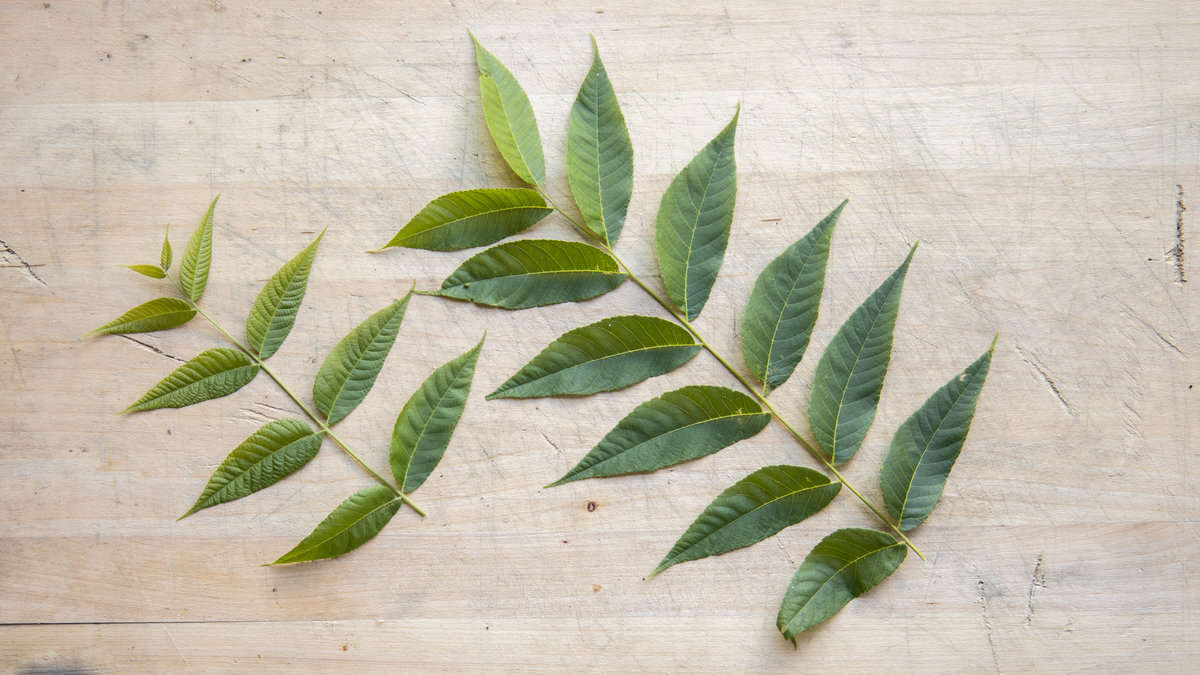
I had to try and make the stuff. I asked around and found out my grandparents had a couple black walnut trees on their property. For my maiden voyage, I went out and picked walnuts off the ground, but I had no idea what I was doing--any walnut would do.
Walnut shells, walnut cores with the green shell removed, brown walnuts, half rotten looking walnuts, they all went into the bag. A couple days later after leaving them outside for lack of fridge space, I ended up with a bag full of writhing maggots, and walnuts.
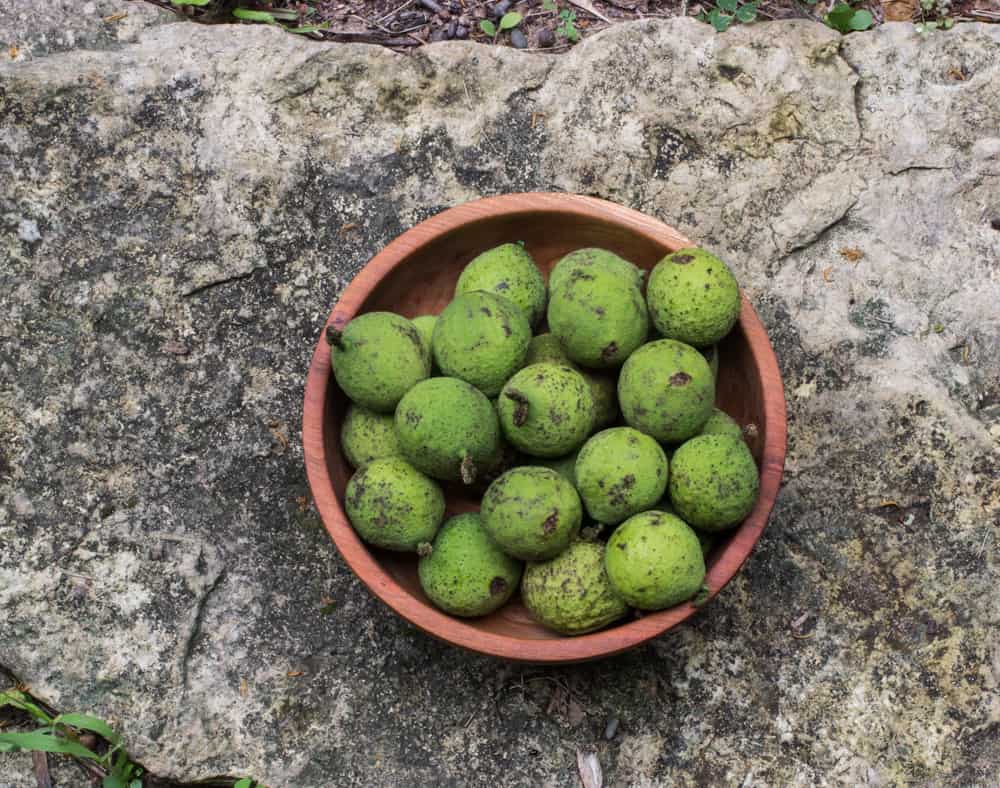
I did a little more research and decided to try and pick the walnuts when they were green, like all the recipes suggested. I tried again, picked all the semi-green walnuts I could find off the ground, and tried to figure out how to break the up.
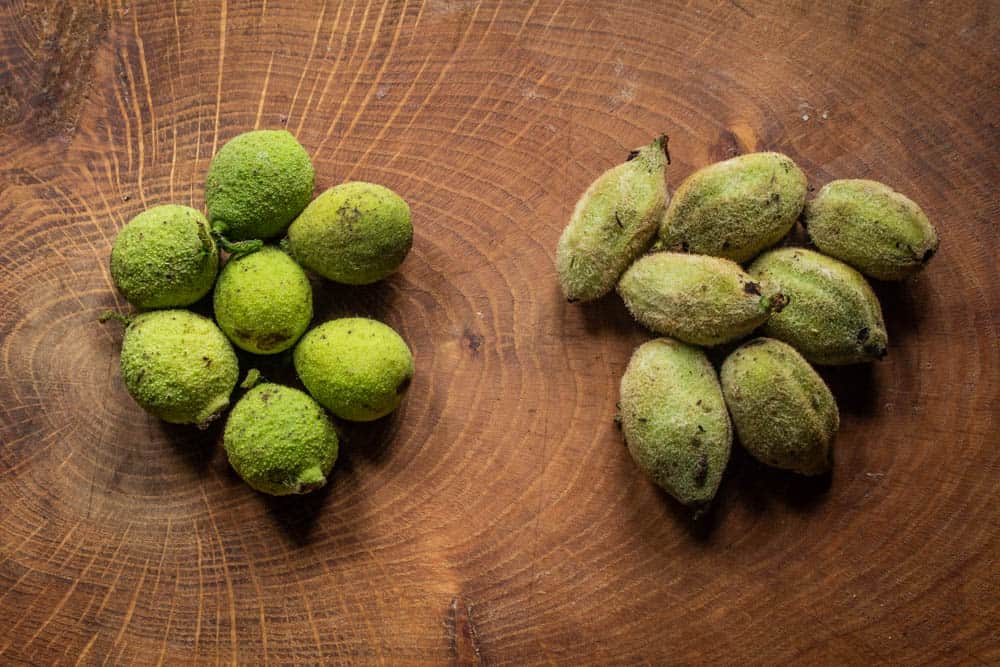
The nuts were just about the hardest thing I’d ever encountered. I brought them into the kitchen at work, thinking there would be some tool available that would work to crack the nuts open.
Fool that I was, I ended up trying to crack open the nuts by beating on them with sauté pans, which only resulted in my throwing away sauté pans I had dented so badly they were completely unusable.

A hammer turned out to be the best bet, after getting a sore thumb from a couple bum whacks I got them cracked, grabbed some vodka and made my nocino.
It turned out ok (sugar makes anything taste good) albeit thick as molasses, a contribution the powdered mature husk gives off if you pick and try to use old nuts, which I don’t recommend.
How young/old should the walnuts be?
In a nutshell, picking the black walnuts on the saint’s day has nothing to do with the saint, but the saint’s day is early in the summer, when the walnuts are soft and the inner shells haven’t developed yet, a paring knife can easily slide through each nut and cutting them is a breeze. I learned my lesson.
As long as you can cut through the green nuts clean with a knife, you will be fine. Even if the nuts have started to form a shell, but the shell is still undeveloped it will still work.
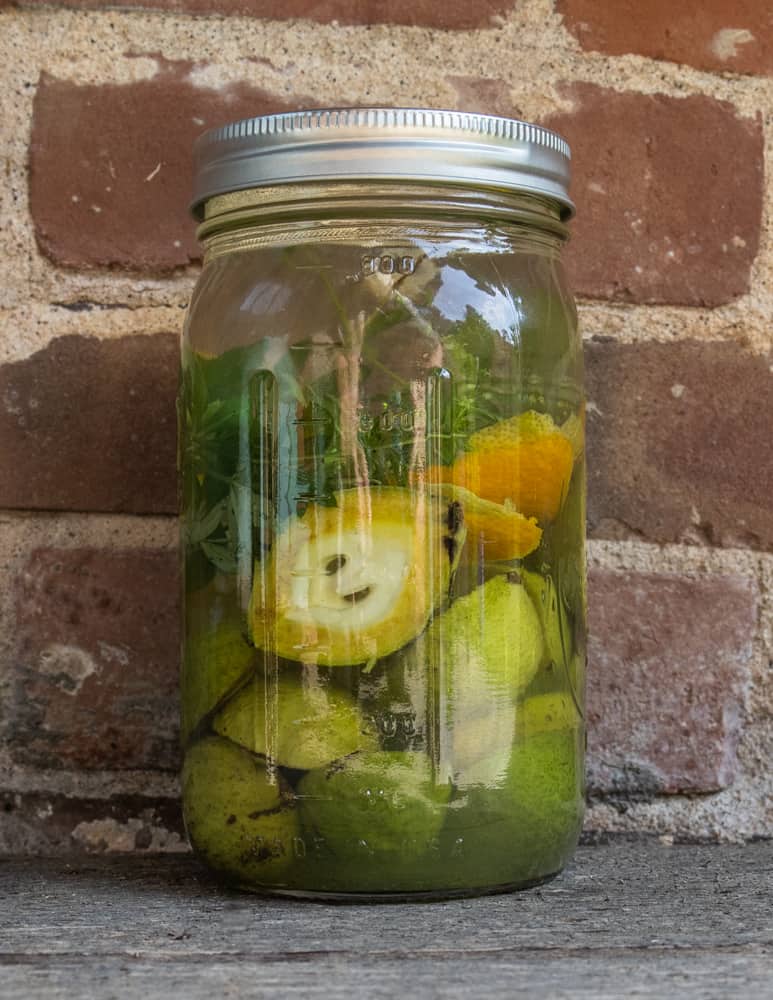

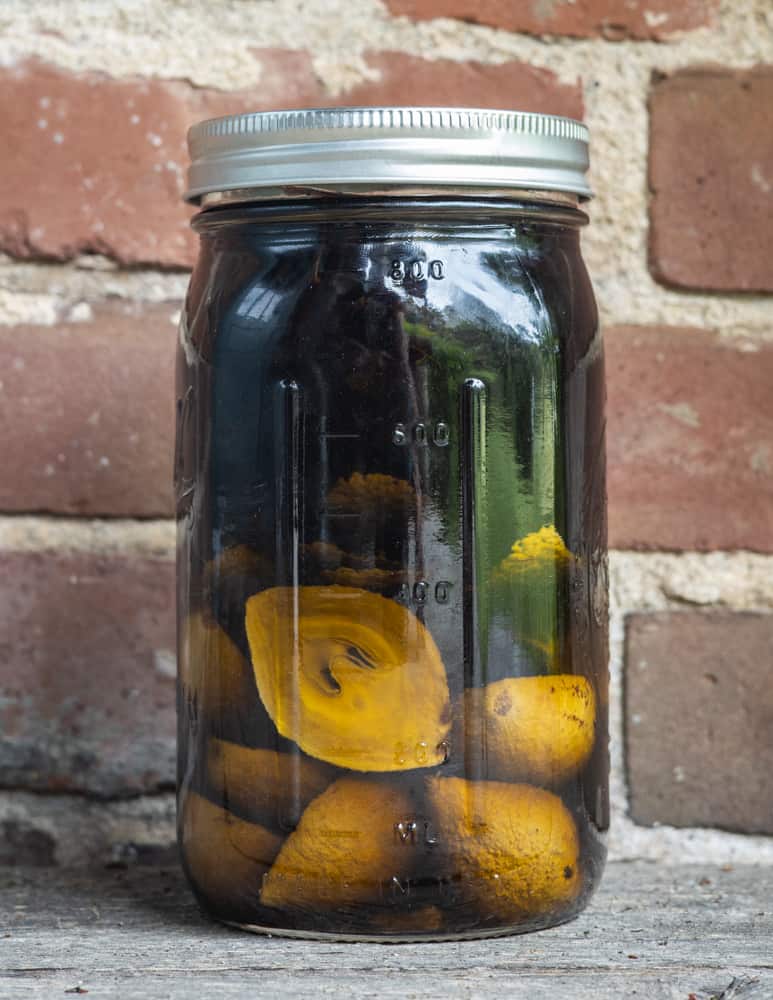
Basic method: the maceration
It couldn't be easier to make nocino, all you need is strong grain alcohol (vodka can work but is not my first choice) and mix it with some unripe nuts, a few very select spices and herbs (or even none at all) put it in a jar, and let it sit for 30 days.
After 30 days, you strain the mixture, thin it and sweeten it a bit (preferably with a tree-based sweetener like maple syrup or my green walnut honey) then bottle it and let it rest for a good 6 months to allow the tannins to soften. That's it!

Spices/additions
As far as the drink itself, the flavor will be different depending on what you put in it, but after making this so many times over the years, I have an important piece of advice for you: DONT GET TOO CREATIVE.
The real character of nocino is in the taste of the nuts themselves, and adding too much cinnamon or strong spices will give you a Christmas-tasting drink.
There is nothing wrong with making nocino with just a few walnuts and a couple cloves, as in 3-4 cloves for a quart jar. Some people add a few coffee beans, which can also be nice.

A few leaves of Galium triflorum, or a handful of chopped angelica stem can be excellent additions though. If you're not familiar with Galium triflorum, I describe it in my book, The Forager Chef's Book of Flora. There's also a recipe for Walnut Wine in the book, which I actually prefer to Nocino.

What's it taste like?
In a nutshell it will end up tasting a bit like black jelly beans, a little bit like Jaegermeister, but milder. After you make a few batches, you will begin to notice the particular flavor green walnuts add. It’s so much more though, after aging for a while it’s delicate, and the bitter tannins of the walnuts disappear, revealing a complex flavor underneath.
Like creme de cassis, It’s great drizzled over ice cream or added to mixed drinks, but most of the time I just pull a jar of it out of the freezer and have a little straight up after dinner or before I turn in.
Making it has become a ritual for me, and I’ve become an evangelist of the stuff. In the restaurant I like to have my crystal decanters full of nocino on a little pedestal in the bar, now and then when I talk to a table I like I bring out the bottle, tell them my story and we each have a few sips, it’s a great way to end a meal.
My Nocino is too sweet/too strong
The basic recipe here may be too sweet for some people. Keep in mind this is more of an idea than an exact recipe, and that you can simply add maple syrup, sugar or water to your taste.
If you find the finished product too sweet or too strong when you are mixing it before the final aging, add some more water. Commercial nocino may be thinned by up to 50% or more.

Commercial Nocinos
Over the past few years there's been a steady increase in the interest of Nocino, and now there are a few different distilleries that make it commercially around the United States.
I work with one of those distilleries (Ida Graves from Alexandria) and I harvest about 2-3 hundreds pounds of green walnuts a year for them. Not all nocinos are created equal though, and I've tasted some commercial ones that are too young for my taste. Remember it takes a good 6 months for those tannins to soften!
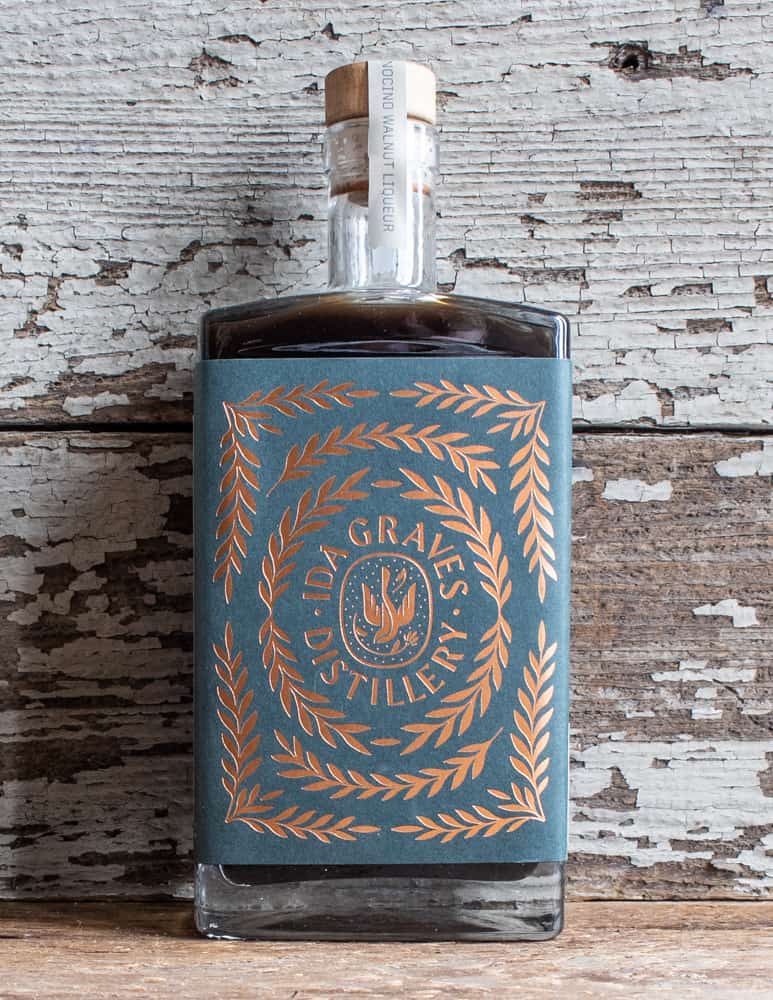

Side note, we're still looking for distribution connections in a few states in the U.S. to help with distributing our product, so if you are in the industry, please reach out to me.
Related Links
Nocino, Black Walnut Liquor
Equipment
- 1 gallon mason jar
- 1 latex gloves
Ingredients
The maceration
- 3 lbs unripe, green black walnuts soft enough that they can be easily cut with a knife
- 1.75 litre (7.4 cups) vodka or substitute everclear, see note
Spices
- 10 whole cloves and/or allspice berries You could omit these and add 2 T good coffee beans instead.
Recommended Additions
- Small handful of Galium triflorum leaves or sweet woodruff Optional, highly recommended
- ½ cup chopped angelica stem or root Optional
Finishing
- 3 cups Maple Syrup or sugar or to taste, see note
- 3 cups Water
Instructions
Maceration
- Wearing gloves, cut the green walnuts in half.
- Combine all the ingredients for the maceration (walnuts, alcohol, spices, and other optional additions) in a glass jar or other non-reactive container and allow to infuse for a month in a cool dark place.
Straining
- After the one month maceration, strain the liquid, discard the solids. Strain the liquid through the finest strainer you have. There will be gunk in the bottom and lots of black-mucky looking material. You may need to wash the strainer during the process if it gets gunked up.
Thinning and sweetening
- Add the water. Add the maple syrup or sugar, whisking and tasting until it tastes good to you.
- You may not want all of the syrup. It should be quite strong as this is served in small amounts, but the exact sweetness is up to you. Some people prefer it candy sweet, I like mine less-so. Do not be put off by the strong, tannic taste of the nocino at this point, it will take months for the tannins to soften.
Aging to soften the tannins
- Store the nocino in air tight containers, such as mason jars and allow to mature for at least 6 months. Taste it occasionally and you will notice how the tannins soften over time. I often keep it in the freezer and enjoy it chilled.
- It makes a strong digestif served in a small glass after dinner.

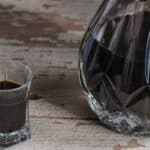
Leftcoaster
Thanks for the idea to use tree based sweeteners for the nocino, I tried maple syrup in my last batch and it made it even tastier and more herbal/tree flavoured. I didn't add any spices, I like it to be just green walnuts and a few young leaf tips plus grain alcohol and I tend to like it a lot less sweet than they do in Italia.
You can make nociato from the spent walnuts after you strain the nocino. One or two bottles of dry white wine poured over to cover the nuts and left for a couple of weeks and then strained will give you a very delicious and lighter aperitivi or digestivo. Kind of a cousin to vin de noix, you can use it as vermouth in mixed drinks as well.
M. Matthews
Hello. First-time nocino maker here. I’ve collected green walnuts that have fallen to the ground (it’s Nov. here). Two questions: Are these still considered “unripe” enough for the recipe? Also, what seems to be an essential step is not clear to me: Do I need to “cut” these into halves or quarters or smaller? Do you cut the outer (green) casing and the nut inside, and how does one do this?
Hope you can help me. I’m excited to start!
Alan Bergo
Hi M, sorry if it seems confusing. Please watch the video embedded in the recipe card or on my You Tube Channel. Nocino is made in the early summer so unless you live in the Southern Hemisphere it's way too late to make it. I'm happy to explain why but it's a much longer reply.
M. Matthews
Thanks, Alan! I’m in southern US (Tennessee), so it sounds like I need to harvest the green walnuts before they hit the ground of their own accord. I’ll make a note to self and be better prepared next time.
Anthony
Thanks for sharing your story. We made a batch and forgot it while the walnuts were in the alcohol due to a number of circumstances. Two years later we discovered the jar. We strained it and found it to be a nice smooth product. I’m wondering however, if there might be any danger to this. Thoughts? A.
Alan Bergo
It’s 100% safe. Alcohol and sugars are preservatives, and you could preserve other ingredients by putting them in the liquid. It’ll be good for years.